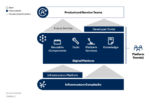
When creating a platform engineering team, an important first step is the interview process. What do developers want and need? What works, and what doesn’t?
Sounds like what companies do when reaching out to customers about new rollouts, right? Well, it is, when you consider your development team as being customers of the platform.
“Treat your developers, treat your DevOps teams, as your own internal customer and interview them,” urged Bill Manning, Solution Engineering Manager at JFrog, which offers a Software Supply Chain platform to speed the secure delivery of new applications and features. Once you’ve listened to the developers, Manning went on, you can roll their feedback into defining your platform engineering approach, which helps organizations find ways to be more efficient, and to create more value by streamlining development.
The reason platform engineering is becoming increasingly important is that over time the process of designing and delivering software has become more complex, requiring a number of different tools and customizations, according to Sean Pratt, product marketing manager at JFrog. “When that happens,” he said, “You lack repeatable processes that can be tracked and measured over time.”
Standardization and intelligent consolidation of tool sets, which can reduce the time, effort and cost needed to manage the sprawl many organizations face, is but one of the core tenets of platform engineering that JFrog talks about. Among the others are reduction of cognitive load, reduction of repetitive tasks through automation, reusable components and tools, repeatable processes, and the idea of developer self-service.
Organizations using DevOps practices have seen the benefits of bringing developers and operations together, to get new features released faster through the implementation of smaller cycles, microservices, GitOps and the cloud. The downside? Coders have now found themselves smack-dab in the middle of operations.
“The complexity [of software] has increased, and even though the tool sets in a way were supposed to simplify, they’ve actually increased it,” Manning said. “A lot of developers are suffering from cognitive overload, saying, ‘Look, I’m a coder. I signed up to build stuff.’ Now they have to go in and figure out how they are going to deploy [and] what is going to be running inside the container. These are things a lot of developers didn’t sign up for.”
Platform engineering has grown out of the need to address the burden organizations have placed on their development teams. By shifting left more practices with which developers are unfamiliar, there’s more responsibility on today’s developers to do more than just design elegant applications.
This all takes a toll on developers. Automating things like Terraform to provision infrastructure, or Helm charts for Kubernetes, for example, frees up developers to do what they do best – innovate and create new features at the pace the business needs to achieve. A developer would rather get a notification that a particular task is done rather than having to dive in and do it manually.
While platform engineering can help standardize on tools, organizations still want to offer developers flexibility. “In a microservice world, for example, certain teams might need to use certain tools to get their job done. One might need to use Java with Jenkins for one project, while another team uses Rust with JFrog Pipelines to execute another project,” Pratt said. “So there’s a need for a solution that can bring all those pieces together under one umbrella, which is something JFrog does to help put consistent processes and practices in place across teams.”
To be sure, a mentality shift is required for successful platform engineering. “You know what, maybe we don’t need 25 tools. Maybe we can get away with five. And we might have to make some compromises, but that’s okay. Because the thing is, it’s actually beneficial in the long term.” Regardless of how many tools you settle on, Manning had a final piece of advice, “Think about how you bring them all together; that’s where universal and integrated platforms can help connect the disparate tools you need.”
Content provided by SD Times and JFrog.





